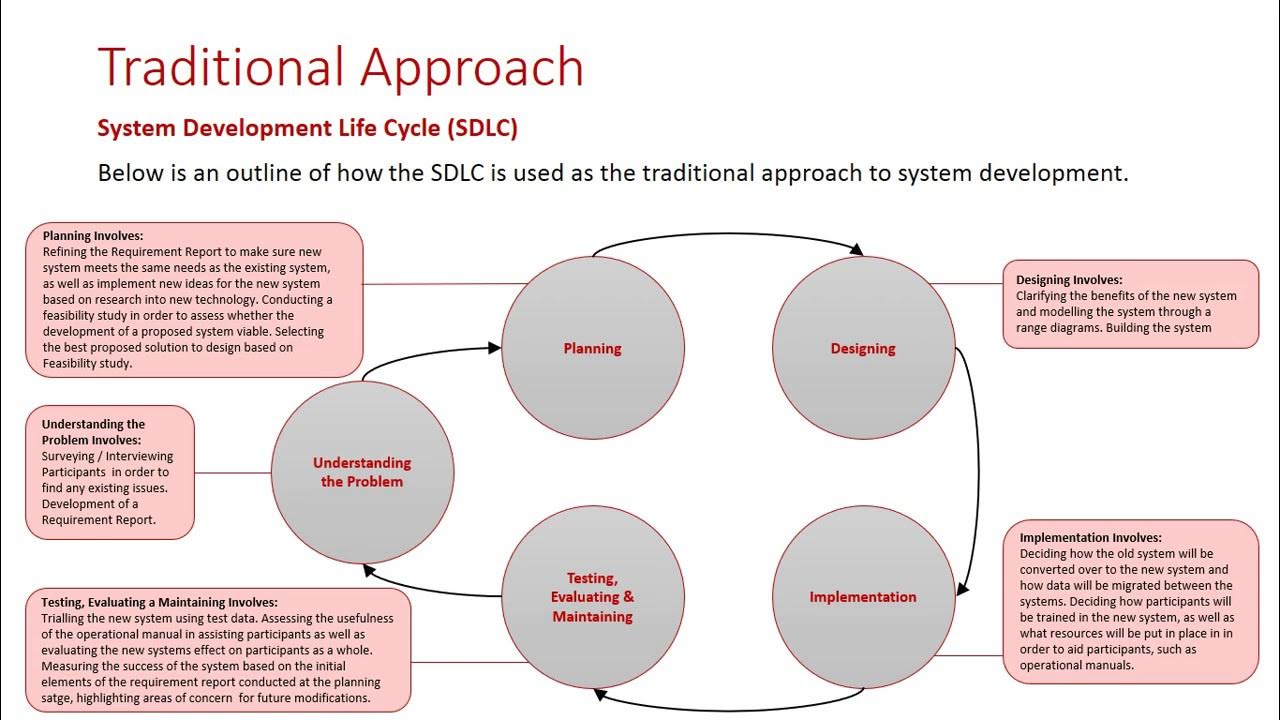Traditional Stages in Developing a System: Understanding the Problem
Summary
TLDRThe first stage of the traditional Waterfall model in system development, 'Understanding the Problem,' focuses on investigating the existing system to determine if it meets organizational needs or if a new system is required. This involves data collection through user and participant interviews, surveys, and system observations. By gathering feedback and analyzing system performance, project teams identify issues with the current system and outline the requirements for the potential new system. The outcome is typically a requirements report or prototype to guide further development.
Takeaways
- 😀 The 'understanding the problem' stage is the first step in the traditional waterfall model of system development.
- 😀 This stage focuses on investigating the requirements and issues of an existing system to determine if a new system is necessary.
- 😀 The outcome of the 'understanding the problem' stage may include a requirements report or prototype to clarify what aspects of the old system need to be carried over.
- 😀 The primary goal of this stage is to understand the existing system’s functionality and identify any issues that may require a new system.
- 😀 Key methods for collecting data about the existing system include interviews, surveys, and direct interaction with the system itself.
- 😀 Interviews with users provide insights into how the system is used and its strengths and weaknesses from a user perspective.
- 😀 Surveys can be distributed to a large number of users to gather more generalized feedback on the system's performance and issues.
- 😀 Participants, such as database administrators or specialized system users, offer detailed perspectives on how the system functions and its specific technical requirements.
- 😀 Direct interaction with the system, including observing users and testing its functionality, helps project teams understand how the system works in practice.
- 😀 The ultimate objective is to assess the system’s usability and determine if it still meets the organization’s needs or if a new system should be developed.
Q & A
What is the first stage of the traditional system development process?
-The first stage is 'understanding the problem,' where the project team investigates the requirements and issues of an existing system to determine if a new system is necessary.
What does the 'understanding the problem' stage involve?
-It involves analyzing the existing system to understand how it works, identify problems, and decide whether a new system is needed. This stage results in a requirements report or prototype.
What are 'requirements' in the context of system development?
-Requirements are the elements of the existing system that need to be carried over to the new system, or adjustments that should be made. These are identified during the 'understanding the problem' stage.
How is data about the existing system typically collected?
-Data is collected through methods such as surveys, interviews, and direct observation of users and participants interacting with the system.
What role do users play in the system development process?
-Users, who interact with the system for its intended purpose, provide valuable insights into the system's performance. Their input helps identify whether the current system meets their needs.
How do participants differ from users in the context of system analysis?
-Participants are a subset of users who have a more detailed, specific role in the system, such as database administrators. Their feedback is crucial for understanding the technical aspects and how the system operates.
Why is it important to interview participants during system analysis?
-Participants, due to their specific roles (like database administrators), offer technical insights into the system's structure, such as storage methods and software usage, which are essential for understanding and improving the system.
What can the project team learn by experimenting with the system itself?
-By interacting with the system, the project team can assess its functionality, understand its features, and identify any issues or inefficiencies. They can also observe how users and participants engage with it.
What is the purpose of observing users and participants interacting with the system?
-Observing users and participants provides a better understanding of how the system works in practice and helps identify any challenges or limitations in its current design.
What happens after the 'understanding the problem' stage if a new system is deemed necessary?
-If the existing system is found to be inadequate, the project team moves on to the next stage of system development, which involves designing and developing a new system based on the identified requirements.
Outlines

Этот раздел доступен только подписчикам платных тарифов. Пожалуйста, перейдите на платный тариф для доступа.
Перейти на платный тарифMindmap

Этот раздел доступен только подписчикам платных тарифов. Пожалуйста, перейдите на платный тариф для доступа.
Перейти на платный тарифKeywords

Этот раздел доступен только подписчикам платных тарифов. Пожалуйста, перейдите на платный тариф для доступа.
Перейти на платный тарифHighlights

Этот раздел доступен только подписчикам платных тарифов. Пожалуйста, перейдите на платный тариф для доступа.
Перейти на платный тарифTranscripts

Этот раздел доступен только подписчикам платных тарифов. Пожалуйста, перейдите на платный тариф для доступа.
Перейти на платный тарифПосмотреть больше похожих видео

Choosing the Appropriate Development Approach: Traditional

5 TAHAP DAUR PENGEMBANGAN SISTEM INFORMASI MANAJEMEN | ANSHAR AKIL

Teknik Pengumpulan Kebutuhan : Wawancara dan Joint Application Develpment

Prof C lectures on Stability: S plane ,poles and zeros

Software Testing Tutorial #9 - V Model in Software Engineering

Software Testing Tutorial #15 - What is Acceptance Testing
5.0 / 5 (0 votes)
